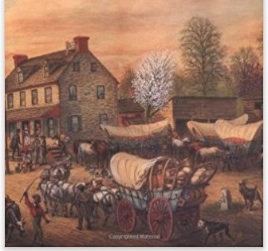We look at the social history of the New Nation from perspectives of Virginia migration among whites and blacks in “Bound Away”. A structural analysis of the Constitution and its pro-slavery uses by Courts and Congresses in the New Nation is considered in “Slavery and the Founders”.
“Plowshares into Swords” looks at the development of a revolutionary consciousness among Richmond urban blacks and their surrounding plantation environs based on evangelical and ideological influences. “Jefferson and the Indians” investigates the evolving U.S. policy responding to the Native American adherence to their customary society in the face of continuing westward settlement.
These books are all used in bibliographies found in peer reviewed surveys of Virginia history of scholarly merit. Insights are used from articles in The Virginia Magazine of History and Biography, the Journal of Southern History and the Journal of American History.
For book reviews of this historical period in other topics, see Revolution-Constitution-New Nation. General surveys of Virginia History can be found at Virginia History Surveys. Virginia history divided by time periods can be found at the webpage Books and Reviews.
Bound Away

Bound Away: Virginia and the Westward Movement was written by David Hackett Fischer and James C. Kelly in 2000. It examines three centuries of Virginia migration, into the colony, diversification within the Old Dominion, and out-migration from Virginia to the western frontier, mainly to Kentucky and Ohio.
The changes wrought by migrations show how Virginia’s hierarchical society was formed with a small ruling elite, a small middling class and two “degraded proletarians” of white and black. Placing migrations of both free and enslaved in common perspective accounts for about a million free and a half million slaves “westering” from Virginia between the Revolution and the Civil War, diminishing population, political clout and economic importance.
While Virginia exported more people, institutions and traditions west than any other state, it was unable to sustain its economy relative to the expansive growth in other regions. Learn more to buy “Bound Away” here for your bookshelf.
Slavery and the Founders

Slavery and the Founders: Race and Liberty in the Age of Jefferson was written by Paul Finkelman in 1996 and reprinted in 2001 and 2014. It is a volume of six essays. They explore Finkelman’s structural analysis of the Constitutional Convention and the pro-slavery purposes subsequent Courts and Congresses put various clauses that may have been neutral at the start of the New Nation.
Slavery is also considered in light of the Northwest Ordinance and the persistence of slavery in that region, as well as the 1793 Fugitive Slave Act. The final two essays address the “character issue” of Thomas Jefferson and Finkelman’s disappointment in Jefferson’s performance on slavery. Learn more to buy “Slavery and the Founders” here for your bookshelf.
Plowshares into Swords

Ploughshares into Swords: Race, Rebellion, and Identity in Gabriel’s Virginia, 1730-1810 was written by James Sidbury in 1997. It develops perspectives on 1800s Gabriel’s Rebellion and Richmond’s black community in the post-revolutionary era. There was a transformation from “blacks in Virginia” to “Black Virginians” with an opposition culture.
After 1750, there arose a racial consciousness among the creole plantation and urban generations of African Americans, influenced both by evangelical Christianity of Methodists, Baptists and the Great Awakening, and by revolutionary ideology of the American and Haitian Revolutions.
Black Virginians turned the culture of the Virginia elite upside down, appropriating some of its symbols for revolutionary purposes to end slavery. Social practice in Richmond included hiring systems and greater personal opportunity as well as bi-racial contacts unavailable on plantations, but “crosscutting” identities based on gender, race and labor led to a complicated picture of post-Gabriel Richmond. Learn more to buy “Plowshares into Swords” here for your bookshelf.
Jefferson and the Indians

Jefferson and the Indians: The Tragic Fate of the First Americans was written by Anthony F. C. Wallace in 1999 and reprinted in 2001. It focuses on Jefferson as Enlightenment philosopher admiring of Native Americans, and Jefferson as President of a United States with evolving Indian policies.
Jefferson’s transparent intent was for peaceful relations with native warriors, he sought their adoption of family farming practices, and encouraged the end of their communal society for a European one based on the individual. When they refused to engage in a cultural transformation and made war on the United States, Jefferson sought their destruction and surrender of tribal lands, with thirty treaties among a dozen tribal groups and the surrender of some 200,000 square miles of territory in nine states. Learn more to buy “Jefferson and the Indians” here for your bookshelf.
These books are all used in bibliographies found in peer reviewed surveys of Virginia history of scholarly merit. Insights are used from articles in The Virginia Magazine of History and Biography, the Journal of Southern History and the Journal of American History.
For book reviews of this historical period in other topics, see Revolution-Constitution-New Nation. General surveys of Virginia History can be found at Virginia History Surveys. Virginia history divided by time periods can be found at the webpage Books and Reviews.

